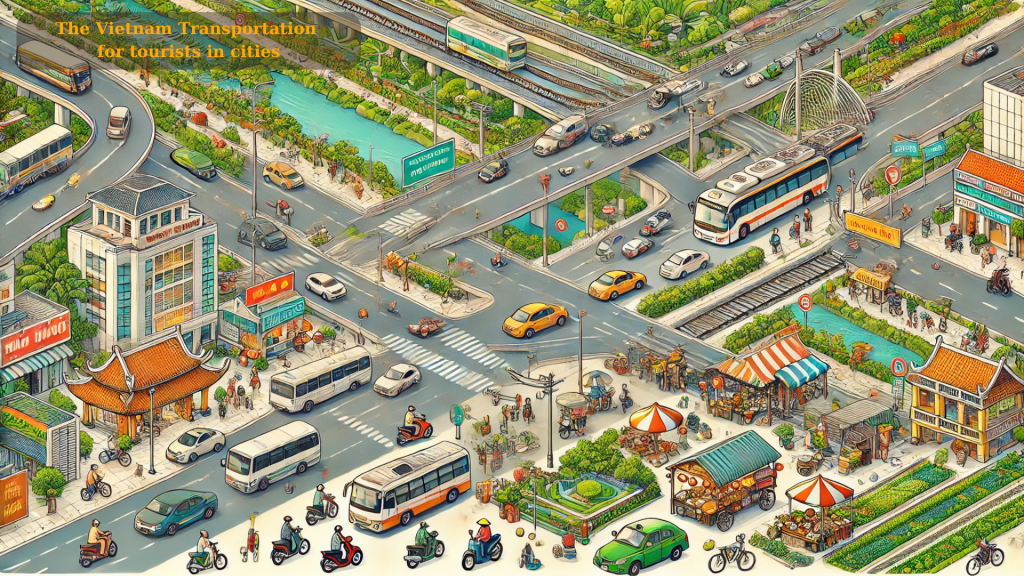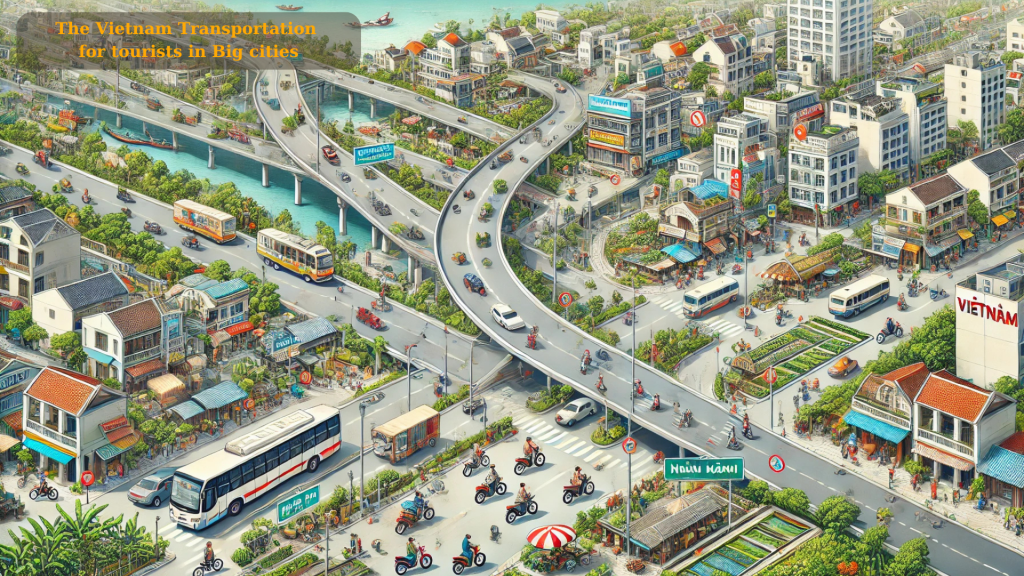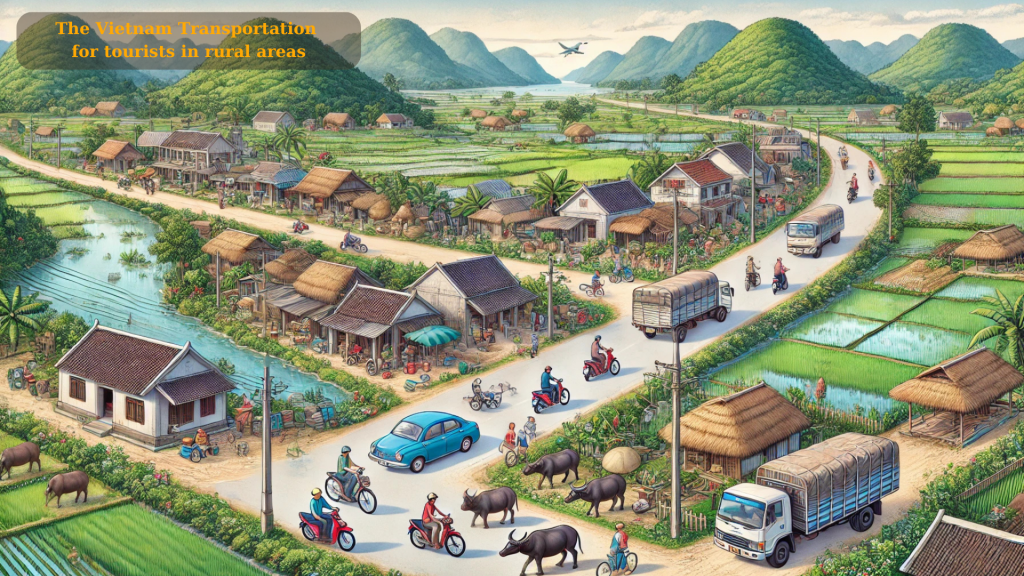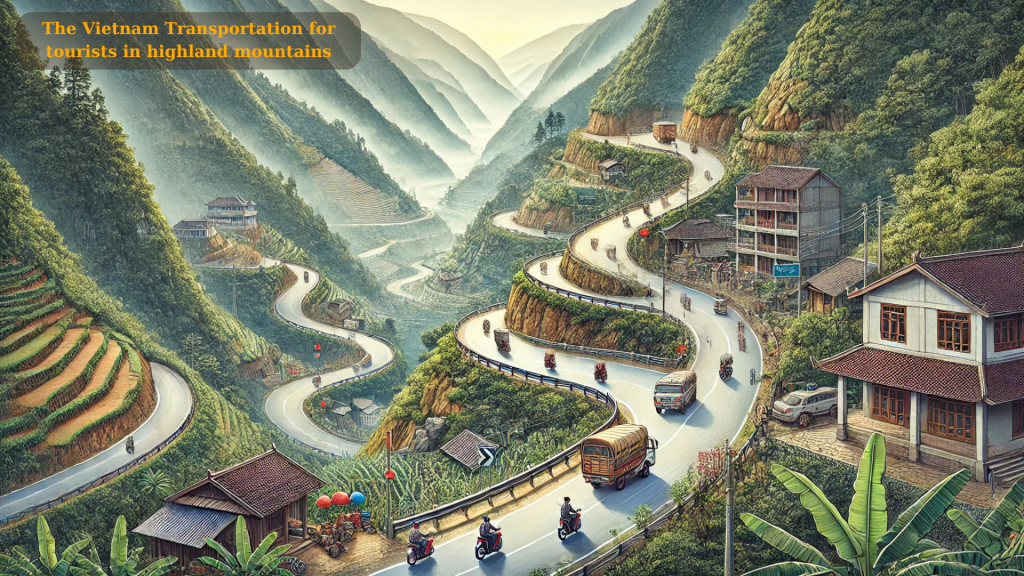Are you wondering what the transportation system is like in Vietnam? Let’s find out with Fito how to become a pro with a Vietnam transportation guide!
Vietnam’s diverse transportation system offers travelers multiple ways to explore this fascinating country. From modern airports to traditional sampan boats, understanding your transportation options is crucial for a smooth journey. This comprehensive guide will help you navigate Vietnam’s transportation landscape, whether planning a short city stay or an extended cross-country adventure.
Mục lục tóm tắt
How to Get into Vietnam for Foreigners
Visa Requirements
- E-Visa:
- Who’s Eligible?: All nationalities, including the US, UK, Australia, and EU countries.
- How to Apply: Submit passport details and a photo on the official e-visa portal.
- Cost: $25 for a 30-day, single-entry visa (processed in 3–5 days). Need more time with sensitive times such as Tet Holiday, Christmas, and New Year,…
- Visa on Arrival (VOA):
- A pre-approval letter is required (apply via agencies like Vietnamvisa.in).
- Present the letter + 2 passport photos + stamping fees ($25 – $50) at airports.
- Visa-Free Entry:
- ASEAN nationals (14–30 days).
- Check your country’s bilateral agreements.

Entry Points to Vietnam: Vietnam Transportation Guide
International Airports: Vietnam’s aviation network includes 13 international airports strategically located across the country:
- Northern Region
- Noi Bai International Airport (Hanoi)
- Cat Bi International Airport (Hai Phong)
- Van Don International Airport (Quang Ninh)
- Tho Xuan International Airport (Thanh Hoa)
- Central Region
- Dong Hoi International Airport (Quang Binh)
- Phu Bai International Airport (Thua Thien Hue)
- Da Nang International Airport
- Phu Cat International Airport (Binh Dinh)
- Cam Ranh International Airport (Khanh Hoa)
- Lien Khuong International Airport (Lam Dong)
- Southern Region
- Tan Son Nhat International Airport (Ho Chi Minh City)
- Can Tho International Airport
- Phu Quoc International Airport (Kien Giang)
Land Border Gates: Vietnam shares borders with China, Laos, and Cambodia, accessible through 16 international land border gates ( for E-visa, can not apply Visa on Arrival)
- Northern Border (Vietnam-China)
- Mong Cai (Quang Ninh)
- Huu Nghi (Lang Son)
- Lao Cai
- Western Border (Vietnam-Laos)
- Tay Trang (Dien Bien)
- Na Meo (Thanh Hoa)
- Nam Can (Nghe An)
- Cau Treo (Ha Tinh)
- Cha Lo (Quang Binh)
- La Lay and Lao Bao (Quang Tri)
- Bo Y (Kon Tum)
- Southwestern Border (Vietnam-Cambodia)
- Moc Bai and Xa Mat (Tay Ninh)
- Tinh Bien and Vinh Xuong (An Giang)
- Ha Tien (Kien Giang)
Sea Border Gates: Vietnam’s coastline features 13 international seaports:
- Northern Coast
- Hon Gai (Quang Ninh)
- Cam Pha (Quang Ninh)
- Hai Phong
- Nghi Son (Thanh Hoa)
- Vung Ang (Ha Tinh)
- Central Coast
- Chan May (Thua Thien Hue)
- Da Nang
- Dung Quat (Quang Ngai)
- Quy Nhon (Binh Dinh)
- Nha Trang (Khanh Hoa)
- Southern Coast
- Vung Tau (Ba Ria – Vung Tau)
- Ho Chi Minh City
- Duong Dong (Kien Giang)
This organization of entry points reflects Vietnam’s commitment to international connectivity and provides travelers with multiple options for entering the country based on their location and preferred mode of transportation.
Getting Around Vietnam: Domestic Transport Options
Domestic Flights
Vietnam’s domestic air network offers efficient travel between major cities:
Major Airlines:
- Vietnam Airlines (full-service carrier)
- VietJet Air (low-cost carrier)
- Bamboo Airways (hybrid carrier)
- Pacific Airlines (low-cost carrier)
Booking Strategies:
- Book 2-3 months ahead for best prices
- Compare prices across airlines
- Consider flexible dates for better rates
- Watch for promotional fares
- Price range: USD 30-150 per flight
Popular Routes:
- Hanoi – Ho Chi Minh City (2 hours)
- Hanoi – Da Nang (1 hour 15 minutes)
- Ho Chi Minh City – Da Nang (1 hour 15 minutes)
- Ho Chi Minh City – Phu Quoc (1 hour)
Train Travel – Vietnam Transportation Guide
Vietnam’s railway system offers a classic way to experience the country’s landscape, particularly the scenic North-South route.
North-South Railway (Reunification Express):
- Total route: Hanoi to Ho Chi Minh City
- Duration: 30-40 hours complete journey
- Major stops: Hue, Da Nang, Nha Trang
- Best for: Scenic views, overnight travel
Ticket Classes:
- Soft Sleeper (4 berths per cabin)
- Most comfortable option
- Air conditioning
- Clean bedding provided
- Price: USD 60-100 per berth
- Hard Sleeper (6 berths per cabin)
- More economical choice
- Air conditioning
- Basic bedding
- Price: USD 45-70 per berth
- Soft Seat
- Suitable for day trips
- Air conditioning
- Price: USD 30-50
Booking Procedures:
- Purchase tickets at train stations
- Book online through the official website
- Use authorized travel agents
- Reserve 2-3 days ahead minimum
- Peak season requires weeks advance booking
Vietnam Long-distance Buses
Bus travel provides an economical way to reach most destinations in Vietnam.
Types of Services:
- Open Tour Buses
- Popular with tourists
- Hop-on, hop-off flexibility
- Major tourist routes covered
- Air conditioning and WiFi
- Price: USD 15-30 per segment
- Sleeper Buses
- Overnight travel option
- Reclining seats/beds
- Air conditioning
- The bathroom stops every 4 hours (many buses have toilets inside)
- Price: USD 20-40 for long routes
- Local Buses
- Most economical option
- Basic amenities
- Frequent stops
- Better for shorter distances
- Price: USD 10-20 per trip
- Top Companies: Futa Bus (orange buses), The Sinh Tourist.
Safety Considerations:
- Choose reputable companies
- Keep valuables close
- Note emergency exits
- Avoid night travel in mountainous areas
- Check weather conditions
Motorbikes
- Rentals:
- Cost: USD 10-20/day (automatic scooters).
- Requirements: Passport deposit (no license needed for rentals, but check insurance).
- Top Routes:
- Ha Giang Loop: 3–4 days through mountain passes.
- Hai Van Pass: Coastal road between Da Nang and Hue.
- Safety:
- Wear helmets (legally required).
- Avoid driving in Hanoi/HCMC traffic.

Urban Vietnam Transportation Guide
Major Cities
Hanoi:
- Public Buses
- Extensive network
- Price: VND 8,000-50,000 per trip
- Air-conditioned buses available
- Route maps at major stops
- Taxis
- Mai Linh (green)
- Vinasun (white)
- Starting fare: VND 14,000
- Per kilometer: VND 15000-18,000
Ho Chi Minh City:
- Bus Rapid Transit
- Modern air-conditioned fleet
- Price: VND 6,000-12,000
- Electronic payment options
- Real-time tracking available
- Metro System (Under Construction)
- Line 1 is partially operational
- Modern facilities
- Affordable fares planned
Da Nang City
- Public Transportation
- New bus fleet
- Tourist-friendly routes
- Beach-city connections
- Price: VND 5,000-20,000
- Bicycle Sharing
- Multiple stations
- App-based rental
- Affordable hourly rates
- Popular along beach routes
Ride-Hailing Services
Popular Applications:
- Grab/Be
- Most widely used
- Multiple vehicle options
- Upfront pricing
- English interface
- Cashless payment option
Safety Guidelines:
- Follow real-time trip tracking
- Verify driver and vehicle details
- Share trip details with others
- Use in-app emergency features
- Keep emergency contacts handy
Rural and Provincial Travel Transportation Guide
Local Transportation Options
Rural Vietnam offers unique transportation challenges and opportunities. Understanding your options ensures a comfortable exploration of the countryside.
Local Bus Networks Most provinces operate local bus services connecting major towns and villages. These services typically operate from early morning until early evening. Expect basic but functional vehicles with natural ventilation. Fares are collected by conductors and usually range from VND 10,000-50,000 depending on distance.
Motorcycle Rentals Renting a motorcycle provides maximum flexibility for exploring rural areas. Reputable rental shops require:
- Valid international driving license
- Passport deposit or copy
- Daily rates: USD 10-20
- Insurance options available
- Basic maintenance knowledge recommended
Private Car Hire For families or groups, private car hire offers comfort and convenience. Services include:
- Daily rates from USD 50-100 with driver
- Air-conditioned vehicles
- English-speaking drivers available
- Customizable itineraries
- Advance booking recommended
Remote Area Considerations
Weather and Seasonal Factors Northern mountainous regions experience significant seasonal variations affecting travel:
- October to March: Cool, occasional rain
- April to September: Hot, possible heavy rainfall
- Check road conditions during rainy season
- Plan extra travel time during adverse weather
Access to Tourist Sites Remote attractions often require specialized transportation:
- Sapa rice terraces: Jeep tours available
- Ha Giang loop: Motorcycle guides recommended
- National parks: Tour operator transport
- Remote beaches: Boat services
Specialized Transport
Water Transportation
- Mekong Delta The region’s waterways offer essential transportation options:
- Regular ferry services between islands
- Small sampan boats for canal exploration
- Speed boats for longer distances
- Private boat charters are available
- Prices vary by distance and vessel type
- Ha Long Bay Cruises Various vessel options cater to different preferences:
- Luxury cruises: USD 150-300 per person/night
- Mid-range boats: USD 80-150 per person/night
- Day trips: USD 50-100 per person
- Transfer services from Hanoi included
- Booking through licensed operators recommended
- River Transportation Major rivers offer both practical transport and tourism opportunities:
- Perfume River (Hue): Traditional dragon boats
- Red River (Hanoi): Dinner cruises
- Saigon River: Speedboat services
- Thu Bon River (Hoi An): Local ferry services
Adventure Transportation
- Motorcycle Tours Organized tours provide safe adventure experiences:
- Easy Rider tours: USD 75-100 per day
- Multi-day tours with accommodation
- Experienced guides included
- Safety equipment provided
- Insurance coverage essential
- Bicycle Tours Eco-friendly exploration options include:
- City tours: USD 25-40 per day
- Countryside excursions
- Mountain biking adventures
- Equipment and guides provided
- Fitness level considerations
Practical Information of Vietnam Transportation Guide
Safety and Security
- Traffic Safety Understanding local traffic patterns is crucial:
- Traffic flows like “schools of fish”
- Pedestrians yield to vehicles
- Use designated crossings when available
- Walk predictably and steadily
- Make eye contact with drivers
- Common Transportation Scams Stay alert for common issues:
- Incorrect taxi meters
- Overcharging for short trips
- Unofficial transport operators
- Luggage handling fees
- Always agree on prices beforehand
- Emergency Contacts Keep these numbers accessible:
- Police: 113
- Ambulance: 115
- Tourist Police: 0969.996.666
- Local police stations in each district
- Your embassy’s emergency number

Digital Resources
Essential Mobile Applications Modern travel in Vietnam benefits greatly from digital tools. The following applications enhance your transportation experience:
- Google Maps – Great for Vietnam Transportation Guide
- Offers reliable navigation in most cities
- Provides real-time traffic updates
- Shows public transportation routes
- Works offline when maps are downloaded
- Integrates with ride-hailing services
- Local Transportation Apps Download these essential applications before arrival:
- Grab: Primary ride-hailing service
- Vietnam Railways: Official train booking platform
- FUTA Bus Lines: Inter-city bus reservations
- Live Train Vietnam: Real-time train tracking
- Vietnam Airports: Flight information and updates
- Language Translation Tools Overcome communication barriers with:
- Google Translate with Vietnamese offline package
- Voice translation capabilities
- Camera translation for signs
- Basic transportation phrase dictionary
- Local language learning apps
Vietnam Regional Transportation Guides
Northern Vietnam
- Hanoi Region The capital serves as the primary transportation hub for northern exploration:
- Efficient public bus network within city limits
- Regular connections to Ha Long Bay (4 hours)
- Daily trains to Sapa (8-9 hours)
- Convenient airport access to regional destinations
- Multiple bus terminals serving different directions
- Sapa Region This mountainous area requires specialized transportation consideration:
- Overnight trains from Hanoi
- Premium minibus services
- Local taxi services for short trips
- Motorcycle rentals for experienced riders
- Cable car to Fansipan mountain
- Ha Long Bay Area Access to this UNESCO World Heritage site involves:
- Luxury limousine buses from Hanoi
- Speed boat services between islands
- Local taxi services in Ha Long City
- Day trip options from Hanoi
- Private car services with flexible scheduling
Central Vietnam
- Hue-Hoi An-Da Nang Triangle This popular tourist route offers multiple transportation options:
- Short flights between major cities
- Scenic train journeys along the coast
- Private car services over Hai Van Pass
- Public buses connecting all three cities
- Motorcycle tours for adventure seekers
- Coastal Routes Exploring central Vietnam’s coastline:
- Regular bus services between beach towns
- Train stations at major coastal cities
- Private car rentals with drivers
- Motorcycle routes along coastal highways
- Local boats for island access
Southern Vietnam
- Ho Chi Minh City Area The southern hub provides extensive transportation networks:
- Modern bus system within the city
- Connections to Mekong Delta provinces
- Regular flights to coastal destinations
- River bus services
- Extensive taxi and ride-hailing coverage
- Mekong Delta Region Navigating the water world of southern Vietnam:
- Speedboat services between provinces
- Local ferry networks
- River cruise options
- Bus connections to Cambodia
- Private boat charters are available
Cost Planning and Budgeting
Vietnam Transportation Budget Guidelines:
- Budget Travel: USD 10-20 per day
- Mid-range: USD 20-50 per day
- Luxury Travel: USD 50+ per day
Money-Saving Strategies:
- Book domestic flights in advance
- Use public transportation in cities
- Consider overnight trains for long distances
- Share private car costs with other travelers
- Look for group tour discounts
Emergency Information
Medical Assistance and Healthcare When requiring medical attention during travel:
- International SOS Vietnam: +84 28 3829 8520
- Major hospitals in key cities maintain 24/7 emergency services
- Many ambulance services accept international insurance
- Keep insurance documentation readily available
- Store emergency contact numbers in multiple locations
Embassy Support Your embassy can provide crucial assistance during emergencies:
- Register with your embassy before arrival
- Save embassy emergency contact information
- Understand what services embassies can provide
- Keep digital copies of all important documents
- Know your embassy’s location in Hanoi or Ho Chi Minh City
Insurance Claims For transportation-related incidents:
- Document everything with photographs
- Obtain police reports when necessary
- Keep all receipts and documentation
- Contact your insurance provider immediately
- Follow proper filing procedures for claims

Conclusion – Vietnam Transportation Guide
Successfully navigating Vietnam’s transportation system enhances your travel experience significantly. This comprehensive guide provides the foundation for confident travel throughout the country, whether you’re exploring bustling cities or remote provinces.
Key Recommendations:
- Plan major transportation in advance, especially during peak seasons
- Maintain flexibility in your schedule for unexpected delays
- Keep emergency contacts and important documents easily accessible
- Consider combining different transportation modes for optimal experiences
- Respect local customs and practice patience during your journey
Travel Planning Checklist:
- Secure necessary visas and documentation
- Book major transportation segments in advance
- Download essential transportation applications
- Purchase comprehensive travel insurance
- Arrange airport transfers for arrival
Additional Resources:
- Official Vietnam Tourism Website: www.vietnam.travel
- Vietnam Railways: www.vr.com.vn
- Civil Aviation Authority of Vietnam: www.caa.gov.vn
- Local tourist information centers in major cities
- Online transportation booking platforms
Final Tips for Travelers:
- Learn basic Vietnamese transportation vocabulary
- Carry small denominations of local currency
- Keep an open mind about local transportation methods
- Build extra time into your schedule
- Stay informed about seasonal weather patterns
Remember that transportation in Vietnam continues to evolve rapidly, with new services and infrastructure developments regularly emerging. While this guide provides comprehensive current information, always verify specific details close to your travel dates for the most up-to-date situation. So, if you need more information about Vietnam or need Visa services, tours, or anything else, please let me know. I will support you in the best way!
- Gmail: fitothinh@gmail.com
- Whatsapp: +84 905 835 538
